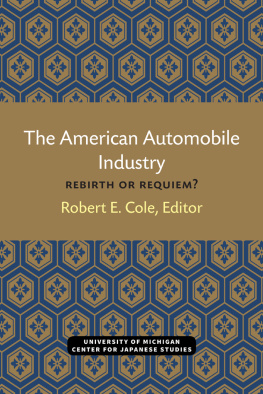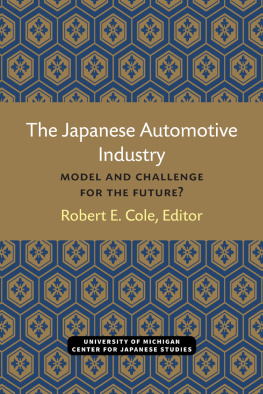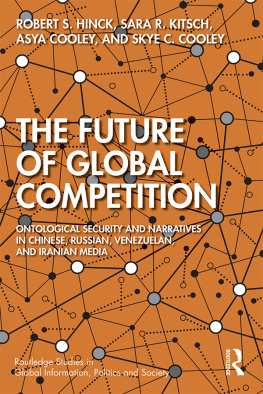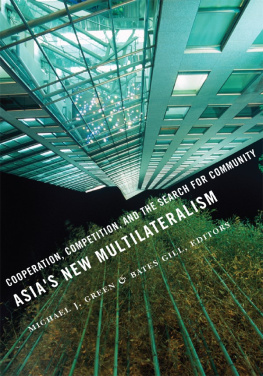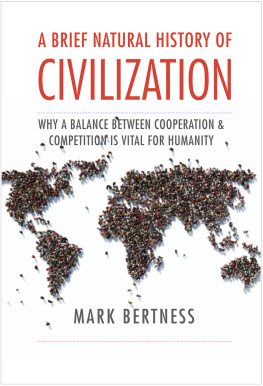Robert E. Cole - Automobiles and the Future: Competition, Cooperation, and Change
Here you can read online Robert E. Cole - Automobiles and the Future: Competition, Cooperation, and Change full text of the book (entire story) in english for free. Download pdf and epub, get meaning, cover and reviews about this ebook. year: 1983, publisher: University of Michigan Center for South and Southeast Asian Studies, genre: Romance novel. Description of the work, (preface) as well as reviews are available. Best literature library LitArk.com created for fans of good reading and offers a wide selection of genres:
Romance novel
Science fiction
Adventure
Detective
Science
History
Home and family
Prose
Art
Politics
Computer
Non-fiction
Religion
Business
Children
Humor
Choose a favorite category and find really read worthwhile books. Enjoy immersion in the world of imagination, feel the emotions of the characters or learn something new for yourself, make an fascinating discovery.

- Book:Automobiles and the Future: Competition, Cooperation, and Change
- Author:
- Publisher:University of Michigan Center for South and Southeast Asian Studies
- Genre:
- Year:1983
- Rating:4 / 5
- Favourites:Add to favourites
- Your mark:
- 80
- 1
- 2
- 3
- 4
- 5
Automobiles and the Future: Competition, Cooperation, and Change: summary, description and annotation
We offer to read an annotation, description, summary or preface (depends on what the author of the book "Automobiles and the Future: Competition, Cooperation, and Change" wrote himself). If you haven't found the necessary information about the book — write in the comments, we will try to find it.
Automobiles and the Future: Competition, Cooperation, and Change — read online for free the complete book (whole text) full work
Below is the text of the book, divided by pages. System saving the place of the last page read, allows you to conveniently read the book "Automobiles and the Future: Competition, Cooperation, and Change" online for free, without having to search again every time where you left off. Put a bookmark, and you can go to the page where you finished reading at any time.
Font size:
Interval:
Bookmark:

THE UNIVERSITY OF MICHIGAN
CENTER FOR JAPANESE STUDIES
MICHIGAN PAPERS IN JAPANESE STUDIES
NO. 10
MICHIGAN PAPERS IN JAPANESE STUDIES
No. 1. Political Leadership in Contemporary Japan, edited by Terry Edward MacDougall.
No. 2. Parties, Candidates and Voters in Japan: Six Quantitative Studies, edited by John Creighton Campbell.
No. 3. The Japanese Automobile Industry: Model and Challenge for the Future?, edited by Robert E. Cole.
No. 4. Survey of Japanese Collections in the United States, 19791980, by Naomi Fukuda.
No. 5. Culture and Religion in Japanese-American Relations: Essays on Uchimura Kanz, 18611930, edited by Ray A. Moore.
No. 6. Sukeroku's Double Identity: The Dramatic Structure of Edo Kabuki, by Barbara E. Thornbury.
No. 7. Industry at the Crossroads, edited by Robert E. Cole.
No. 8. Treelike: The Poetry of Kinoshita Yji, translated by Robert Epp.
No. 9. The New Religions of Japan: A Bibliography of Western-Language Materials, by H. Byron Earhart.
No. 10. Automobiles and the Future: Competition, Cooperation, and Change, edited by Robert E. Cole.
AUTOMOBILES AND THE FUTURE: COMPETITION, COOPERATION, AND CHANGE
edited by
Robert E. Cole
Ann Arbor
Center for Japanese Studies
The University of Michigan
1983
Open access edition funded by the National Endowment for the Humanities/Andrew W. Mellon Foundation Humanities Open Book Program.
ISBN 0-939512-14-9
Copyright 1983
Center for Japanese Studies
The University of Michigan
Library of Congress Cataloging in Publication Data
Automobiles and the future.
(Michigan papers in Japanese studies; no. 10).
Third annual United States-Japan Automotive Conference.
1. Automobile industry and tradeUnited StatesCongresses. 2. Automobile industry and tradeJapanCongresses. 3. Competition, InternationalCongresses. 4. Automobile industry and tradeInternational cooperationCongresses. I. Cole, Robert E. II. United States-Japan Automotive Conference (3rd: 1983: University of Michigan). III. Series.
HD9710.U52A826 1983 338.4'76292'0973 83-14345
ISBN 0-939512-14-9
Printed in the United States of America
ISBN 978-0-939512-14-0 (paper)
ISBN 978-0-472-88011-9 (ebook)
ISBN 978-0-472-90208-8 (open access)
The text of this book is licensed under a Creative Commons Attribution-NonCommercial-NoDerivatives 4.0 International License: https://creativecommons.org/licenses/by-nc-nd/4.0/
CONTENTS
Robert E. Cole
Alfred S. Sussman
Paul W. McCracken
Keichi Oshima
Robert A. Perkins
John F. Smith, Jr.
Irving Bluestone
David Macdonald
Richard C. Wilson
Teruo Maeda
Michael S. Flynn
Paul W. McCracken
At the time we held our 1983 U.S.-Japan auto conference in March, the hoped-for economic recovery as manifested in auto sales had revealed itself quite modestly. Three months later, the indicators are more robust and certainly long overdue for those whose livelihood depends on the health of the industrysome of whom, like myself, are university professors.
With Japanese import restrictions in place until March 1984 and drastically reduced break-even points for domestic manufacturers, rising consumer demand holds great promise for the industry. The rapidly rising stock prices of the automakers captures well the sense of heightened optimism, as do the various forecasts for improved profits.
While the news is certainly welcome, it nevertheless should be greeted with caution. As Mr. Perkins noted at the conference, "we have a tendency to forget things very quickly. If we have a boom market this year, there is a good chance that a lot of the things we learned will be forgotten."
What are the kinds of things that should not be forgotten?
1. While the publicized profit estimates of the Big Three are a welcome change, they still pale in comparison to the $10 billion a year investment in new plant and equipment being required of automakers and parts suppliers just to insure that they stay reasonably competitive. Although top management knows this, they have done a poor job of communicating it to their employees. This reflects the broader problem they have had with information sharing.
2. To achieve sustained productivity improvement requires significant work-rule modification on the part of the unions, and this would necessitate significant management commitments to job security. Institutionalization of pay-for-knowledge systems can be the quid pro quo for breaking down the division of skills and developing a multiskilled labor force.
3. To achieve sustained quality improvement requires that the pressure for production that comes with economic recovery not overwhelm the renewed commitment to quality. Past experience in this regard is not encouraging.
4. The profit and employment improvements that do take place will still be occurring behind the protection of voluntary Japanese import quotas. The persistence of differences in manufacturing costs, as discussed at the conference, means that we have yet to solve the puzzle of competing successfully with the Japanese, certainly at the lower end of the market. The pressure to solve that puzzle can dissipate in the face of the euphoria of a boom year.
5. Government policymakers are likely to breathe a sigh of relief at the improved performance of domestic automakers. While they have good reason to do so, they are likely to forget just how close to the edge we came. And the temptation hereafter will be to dismiss industry and union claims for an improved environment in which to do business. Will they be as eager to pursue an extension of voluntary trade restraints on the part of the Japanese in 1984 as they were at the height of the economic downturn?
6. The automakers have been bravely talking about restructuring their relationships with their suppliers. The effort has gone forward on a variety of fronts, such as quality improvement, just-in-time delivery, and longer-term relationships with fewer suppliers. Yet it is clear from talking with representatives of supplier firms that there is still a great deal of mistrust on the part of suppliers toward these efforts. While there is little doubt that top management of the auto firms sees the need for change, their ability to force these changes through the middle management hierarchy is yet to be fully tested. And economic recovery seems likely to take the heat off pursuing some of these efforts.
7. A strong start has been made in developing new practices allowing for worker participation in shop-floor decision making. Yet progress is uneven and often fragile. Management's efforts to improve productivity, which often pit one plant against another, can easily lead to a derailment of these efforts. Cooperative relations between management and labor historically proceed most effectively in a crisis atmosphere but come apart during prosperity.
8. Principles of joint sacrifice on the part of management and labor, however weakly developed during the crisis, will come under pressure from the various interest groups that believe they have unduly sacrificed and, therefore, are justified in demanding a bigger piece of the pie now that times are better.
9. The auto industry is a mature industry with slow growth in total domestic demand but volatile year-to-year changes. Given this situation plus the persistent pressure from imports, it can be anticipated that another downturn will occur in the not-too-distant future. In the light of the enormous social costs extracted by the current downturn, will we have learned something from this experience that will allow us to proceed more intelligently the next time? How, for example, do we plan to deal with the continued automation and streamlining of the industry and its impacts on employment?
Font size:
Interval:
Bookmark:
Similar books «Automobiles and the Future: Competition, Cooperation, and Change»
Look at similar books to Automobiles and the Future: Competition, Cooperation, and Change. We have selected literature similar in name and meaning in the hope of providing readers with more options to find new, interesting, not yet read works.
Discussion, reviews of the book Automobiles and the Future: Competition, Cooperation, and Change and just readers' own opinions. Leave your comments, write what you think about the work, its meaning or the main characters. Specify what exactly you liked and what you didn't like, and why you think so.


